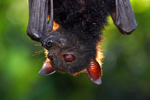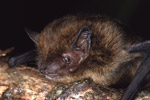Scientists have uncovered a rare, brilliantly-striped bat in South Sudan that has yielded new secrets after close study. Working in Bangangai Game Reserve during July of last year, biologist DeeAnn Redeer and conservationist Adrian Garsdie with Fauna & Flora International (FFI) came across an unmissable bat, which has been dubbed by various media outlets as the “badger bat” and the “panda bat.”
“My attention was immediately drawn to the bat’s strikingly beautiful and distinct pattern of spots and stripes. It was clearly a very extraordinary animal, one that I had never seen before,” DeeAnn Reeder with Bucknell University says. “I knew the second I saw it that it was the find of a lifetime.”
After collecting a specimen, Reeder took the bat back to the U.S. and confirmed that it belongs to a species that was discovered over seventy years ago in the Democratic Republic of the Congo (DRC) in 1939. However, that wasn’t the end of the story.
“After careful analysis, it is clear that it doesn’t belong in the genus that it’s in right now,” Reeder explains. “Its cranial characters, its wing characters, its size, the ears—literally everything you look at doesn’t fit. It’s so unique that we need to create a new genus.”
Reeder and her team dubbed the new genus, Niumbaha, which means “unsual” or “rare” in the language of the local Azande people, changing the full name to Niumbaha superba, which translates to the rare superb bat. Since it’s discovery in 1939, the bat has only been recorded by scientists five times in the DRC, Ghana, and Ivory Coast. Notably, Reeder’s discovery is the first time the species has ever been recorded in South Sudan, which only became an independent country in 2011.
In the paper, the scientists write that this is “one of the most extraordinary and rarest-collected bats in Africa,” but Reeder says more data would be need to estimate its population.
“It is surely very rare, but no reason to suspect it is endangered (except that, of course, habitat loss throughout Africa seriously threatens all wildlife),” Reeder told mongabay.com. The species is currently listed as Least Concern by the IUCN Red List due largely to its massive range.
As far as conservation is concerned, Reeder says, “The first thing is to preserve habitat. This bat was captured in the Bangangai Game Reserve—a protected area. It nearly always boils down to habitat preservation. Bats are often significantly challenged by the bushmeat trade—but I have seen no evidence of bats as food in South Sudan.”
For several decades South Sudan was off-limits to most scientists and conservationists given large-scale conflicts and instability, but the nation likely has a wealth of biological surprises.
“To me, this discovery is significant because it highlights the biological importance of South Sudan and hints that this new nation has many natural wonders yet to be discovered. South Sudan is a country with much to offer and much to protect,” says Matt Rice, FFI’s South Sudan country director. FFI is currently conducting several programs in the new country, including helping to manage Southern National Park, investigating the possibility of surviving northern white rhinos in the country, and aiding the government on conservation efforts.

Niumbaha superba. Photo by: DeeAnn Reeder.

Niumbaha superba. Photo by: DeeAnn Reeder.

Niumbaha superba. Photo by: DeeAnn Reeder.

Niumbaha superba. Photo by: DeeAnn Reeder.

DeeAnn Reeder and Matt Rice with Niumbaha superba specimen. Photo by: DeeAnn Reeder.
CITATION: Reeder DM, Helgen KM, Vodzak ME, Lunde DP, Ejotre I (2013) A new genus for a rare African vespertilionid bat: insights from South Sudan. ZooKeys 285: 89. doi: 10.3897/zookeys.285.4892
Related articles
Bats face new perils from climate change

(11/15/2012) Global climate change could devastate bat populations around the world, threatening to tear yet another thread from the tapestry of biodiversity should current temperature trends persist, according to a new study. “Bats were the focus for this study because they are relatively understudied but due to their sensitivity to environmental stress, they are excellent indicators of climate change,” Hayley Ann Sherwin, co-author of the paper published in Mammal Review, with the Queen University in Belfast, told mongabay.com.
Endangered fruit bats, and many other species, on the menu in the Philippines

(07/09/2012) Bushmeat hunting is well-known to be decimating animal populations in Africa, but has been little studied much of Southeast Asia. However, a new paper in mongabay.com’s open access journal Tropical Conservation Science shines light on the size and scale of bushmeat poaching in the Philippines. Studying an anonymous community near a national park on the island of Luzon, researchers found that poachers targeted 22 species, ten of which are considered either threatened or near threatened with extinction by the IUCN Red List.
Island bat goes extinct after Australian officials hesitate

(05/23/2012) Nights on Christmas Island in the Indian Ocean will never again be the same. The last echolocation call of a tiny bat native to the island, the Christmas Island pipistrelle (Pipistrellus murrayi), was recorded on August 26th 2009, and since then there has been only silence. Perhaps even more alarming is that nothing was done to save the species. According to a new paper in Conservation Letters the bat was lost to extinction while Australian government officials equivocated and delayed action even though they were warned repeatedly that the situation was dire. The Christmas Island pipistrelle is the first mammal to be confirmed extinct in Australia in 50 years.
Disease kills 6 million bats in North America
(01/18/2012) In just six years around six million bats have succumbed to white-nose syndrome in North America, according to U.S. federal researchers. The number, somewhere between 5.7 and 6.7 million bats, is far higher than past estimates of over a million. Showing up in 2006 in New York, the perplexing disease, which appears as white dust on bats’ muzzles, wipes out populations while they hibernate.
Bat-killing culprit identified by scientists
(10/31/2011) First identified in 2005, white-nose syndrome has killed over a million bats in the US, pushing once common species to the edge of collapse and imperiling already-endangered species. Striking when bats hibernate, the disease leaves a white dust on the bat’s muzzle, causing them to starve to death. Long believed to be caused by a fungus in the genus Geomyces, researchers publishing in Nature have confirmed that the disease is produced by the species, Geomyces destructans.